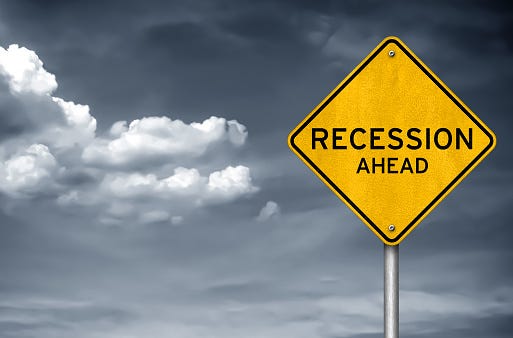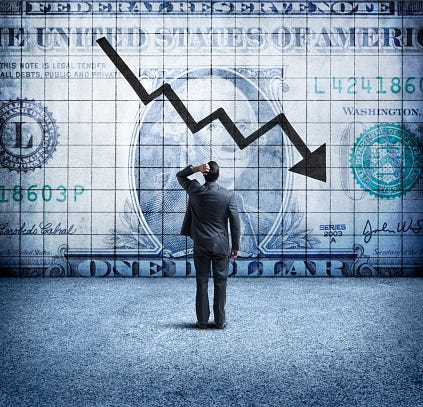Historically, every 8 to 10 years a recession tends to hit the U.S. economy, and one notable indicator has come to proceed each one for the past 40+ years; a steep treasury yield curve inversion.
Today is no exception and with months-long looming Fed-induced recession fears across the street, strategists are pontificating if the economy can get itself out of the woods in 2023.
This will only be the case if the Fed can steer the ship correctly but it may not be in their best interest when their goal is to raise unemployment and curb spending, everything we don’t want to happen.
He has one chance. No pressure Powell.
As the old adage goes, although history repeats itself, it rhythms in different ways. As we quickly approach a hopeful Santa clause rally towards the end of December and as banks come to release their 2023 forecasts for the year, it’s a reassuring sign to notice recession fears have gone down. However, overall predictions are still murky and all over the place for where major indexes will close in 2023.
Some banks on the street are forecasting the S&P closes a little above 4k and some have blown past that as EPS forecasts are out of this world. I guess only time will tell. Even top economists and traders can’t predict the future so don’t feel bad if yours are way off! They aren’t even public! Learn and move on.
Making predictions is a fool’s game, practically throwing darts at a chart with your eyes closed since the world is so unpredictable! No matter how much experience one may possess in investing, clearly, nothing is for certain.
At least that makes the game fair. Even high-paid strategists who will most likely get their bonuses cut this year due to slow dealmaking can’t get it right.

Out of This World
So speaking of predictions, and what all kinds of investors from retail to institutional are hoping to see into 2023, despite the geopolitical headwinds, supply chain constraints, climate crisis concerns, rampant inflation, and deglobalization, signs inflation has peaked have finally come through which may be the most helpful sign that can help deter us away from a Fed-induced recession altogether.
But to play it safe, we cannot forget about history and do our homework. Staying humble and not fighting the Fed is key.
Along with his classic adage, there’s a bull market somewhere, our best friend, Jim Cramer is now stating not just to ‘buy and hold’ but ‘buy and do your homework’. Looking at history can give us a great glimpse into what to predict in the future, especially when it comes to the inversion of treasury yields.
If there’s a leading indicator that always proceeded recessions/depressions in the past such as with the Great Depression in the 30’s to the Great Financial Crisis a.k.a Housing Collapse of ’08, it’s a treasury yield inversion which entails that there’s an inversion in the yield curves for a short and long term treasuries as investors tap into more short term, safe haven assets to protect their cash, and in response buy short term, treasuries, bills and notes that end up yielding higher than treasury bonds that mature past a decade.
Treasury bills and notes that mature within a few months to a year are now yielding higher at around 4%, than long-term treasury bonds, the same case as shown prior to the Great Financial Crisis, and Great Depression. March 2020’s brief correction was an outlier since the recovery was rapid.
Although we have to consider that this is a different time in history as systems are more advanced and banks are much more regulated, the Fed’s job is the same. After two years of major froth, speculation, and cheap dry powder with the meme craze and SPACs, right now it looks like the Fed’s hawkish plans may have cooled down borrowing and spending, and really all eyes are on them to save this country in Q2 ‘23.

Turn to Treasuries Before the Storm
In other news, hopefully, as we head into the final weeks of the year, we get the best present of all this Christmas with a Santa Claus rally so if you’re looking to take advantage of deals on your favorite, big tech stocks, I would suggest buying them sooner than later as they certainly won’t be trading at bargain basement deals forever!
As risk assets over the long term recover and rebound, equities are by far the strongest hold out of any other investment so make sure to buy at the dip and sell at the peak not vice versa as many investors fall into the trap of doing since its more comfortable after all.
When it comes to treasuries and whether or not the inversion will steepen, at least you know they are guaranteed risk-free assets that require no timing, numbers crunching or day trading type guessing.
If you can lock in a guaranteed return above ~3.5%, I would say it’s probably worth it to tap into especially for your short-term cash reserve so it doesn’t erode due to inflation when too many dollars chasing too few goods!
Don’t rely on the banks to stay competitive and pay you above a mere few cents per month since many are not as high-yielding as we’d hoped by now with customer deposits for savings accounts so make sure to shop around just like with Black Friday deals on your investments. Since bonds are having their worst year in over 2 decades, Treasuries certainly won’t be this attractive forever. There are always options out there to get the most bang for your buck without sacrificing time or effort, such as with Treasuries.
Whether it be with asset classes or just major indexes, it never hurts to make your own predictions on the market since clearly strategists and traders are usually off big time as well so might as well try to protect your portfolio and see where your expertise lands.
With a stake in the game, we tend to care more so might as well take it up a notch and make a prediction. Ironically, sometimes the outlier, or those who know the least, knows the most in the end!
Wherever U.S. treasuries end up in Q1 ’23, we know they won’t be at these elevated levels forever. From headwinds to tailwinds, fortunately, unfortunately. nothing lasts forever either way.

